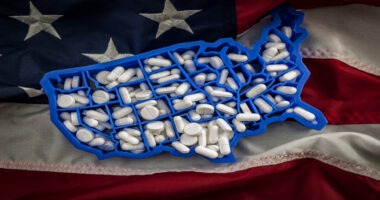Big Pharma & US Manufacturing Investment
The White House released last week a list of major capital investments in the US for manufacturing, including from the pharmaceutical industry. A roundup of investments gaining attention and other moves thus far in 2025.
By Patricia Van Arnum, Editorial Director, DCAT, pvanarnum@dcat.org
US pharma investment making the news
One way in which individual companies have responded to changing US trade policy is to emphasize their investments in US-based manufacturing and R&D activities. Thus far in 2025, many of the large bio/pharmaceutical companies have announced multi-billion, multi-year capital investments in the US as part of already planned investments as well as to highlight additional investment in the US. Below is a roundup of major investments formally announced thus far in 2025.
Johnson & Johnson (J&J). This week (August 21, 2025), J&J announced that it will increase its presence in North Carolina with a 160,000+ square-foot dedicated manufacturing facility at the new biopharmaceutical manufacturing site in Holly Springs, North Carolina of the CDMO, Fujifilm Biotechnologies. The $2-billion commitment to Fujifilm over the next 10 years will expand J&J’s US manufacturing capacity. In the coming months (as reported on August 21, 2025), J&J says it intends to share plans for additional advanced manufacturing facilities in the US as well as expand current US sites to enable the company to manufacture the vast majority of its medicines for US patients in the US.
The $2 billion being invested in North Carolina continues other US investments announced by the company. In March (March 2025), J&J announced manufacturing, research and development, and technology investments of more than $55 billion in the US over the next four years, which includes a $2-billion investment in a 500,000-square-foot biologics manufacturing facility in Wilson, North Carolina, which the company started construction of in March (March 2025). In addition, the multi-year investment includes: (1) three new advanced manufacturing facilities and the expansion of several existing sites across the company’s Innovative Medicine and MedTech businesses; (2) investments in R&D infrastructure for developing therapeutics in areas such as oncology, neuroscience, immunology, and cardiovascular disease as well as investments in robotic surgery; and (3) increased technology investments in drug-discovery and development activities, workforce training, and business operations.
AstraZeneca. Last month (July 2025), AstraZeneca announced plans to invest $50 billion in the US by 2030. The main investment is a new multi-billion dollar US manufacturing facility that will produce drug substances for the company’s weight-management and metabolic portfolio, including an oral GLP-1, baxdrostat, an oral PCSK9 drug, and combination small-molecule products. The new center will produce small molecules, peptides, and oligonucleotides. This investment is in addition to the $3.5 billion the company announced in November 2024.
The drug-substance facility, planned to be in Virginia, would be AstraZeneca’s largest single manufacturing investment globally. The $50-billion investment across its R&D and manufacturing footprint in the US over the next five years also includes: (1) expansion of its R&D facility in Gaithersburg, Maryland; (2) a new R&D center in Kendall Square, Cambridge, Massachusetts; (3) manufacturing facilities for cell therapy in Rockville, Maryland, and Tarzana, California; (4) a continuous manufacturing expansion in Mount Vernon, Indiana; (5) a specialty manufacturing expansion in Coppell, Texas; (5) new sites to supply clinical trials; and (6) additional investment in research and development. Collectively, the company says these investments will help deliver AstraZeneca’s goal of reaching $80 billion in total revenue by 2030, of which it expects 50% would be generated in the US.
Roche. In April (April 2025), Roche announced that it will invest $50 billion in existing and new R&D and manufacturing facilities in its pharmaceuticals and diagnostics operations in the US in the next five years (as reported on April 21, 2025). The investment will include: (1) expanded and upgraded US manufacturing and distribution capabilities for its medicines and diagnostics portfolio in Kentucky, Indiana, New Jersey, Oregon, and California; (2) a gene-therapy manufacturing facility in Pennsylvania; (3) a new manufacturing center in Holly Springs, North Carolina (the location was announced in May 2025, see below) to support Roche’s expanding portfolio of weight-loss medicines; (4) a new manufacturing facility for continuous glucose monitoring in Indiana; (5) a new R&D center in Massachusetts; and (6) an expansion and upgrading of its existing pharmaceuticals and diagnostics R&D centers in Arizona, Indiana, and California.
In May (May 2025), Roche further specified plans for US manufacturing to support its obesity products, which included more than $700 million in a new 700,000-square-foot drug manufacturing facility in Holly Springs, North Carolina. The company said that this initial investment could expand in the future based on business needs and the US policy environment.
Novartis. Novartis announced in April (April 2025) that it will be investing $23 billion over five years in US-based infrastructure in manufacturing, research, and technology across 10 facilities, including seven new facilities. The production capacity will cover both active pharmaceutical ingredients (APIs) and biologic drug substances as well as secondary production and packaging. Specific investments include: (1) establishing a new $1.1-billion research hub in San Diego, California, its second global R&D hub in the US (the other is in Cambridge, Massachusetts), expected to open between 2028 and 2029; (2) building four new manufacturing facilities in soon-to-be-determined states, including three that will make biologic drug substances, drug products, device assembly and packaging, and one facility that will make chemical drug substances, oral solid dosage forms, and packaging; (3) building two new radioligand therapy (RLT) manufacturing facilities in Florida and Texas; and (4) expanding three RLT manufacturing facilities in Indianapolis, Indiana, Millburn, New Jersey, and Carlsbad, California. With these investments, Novartis says it will have manufacturing capacity in the US for all its core technology platforms, including small molecules and biologics.
Sanofi. In May (May 2025), Sanofi announced its intention to invest at least $20 billion in the US through 2030 in R&D and manufacturing. The company says it plans to expand its US manufacturing capacity, both through direct investments in Sanofi sites, as well as through partnerships with other domestic manufacturers.
In its pharmaceuticals business, Sanofi has three R&D sites in the US (as of December 31, 2024): (1) Bridgewater, New Jersey; (2) Cambridge, Massachusetts; and (3) Framingham/Waltham, Massachusetts. Outside the US, it has two operational sites in France: Montpellier and Vitry-sur-Seine/Alfortville; two sites in the rest of Europe (Germany and Belgium), the larger of which is in Frankfurt, Germany; and three sites in China (Beijing, Shanghai and Chengdu).
In its vaccines business, it has three US R&D sites (as of December 31, 2024): (1) Swiftwater, Pennsylvania; (2) Cambridge, Massachusetts; and (3) Orlando, Florida. Outside the US, it has vaccine R&D sites in Marcy-L’Etoile/Lyon, France and Toronto, Canada.
In terms of manufacturing, its medicines industrial operations are organized through end-to-end clusters with four dedicated biotechnology hubs: Paris/Lyon (France), Frankfurt (Germany), Geel (Belgium) and the Boston area (US), as of December 31, 2024. For the industrial operations in its vaccines business, major investments were announced in 2020 and 2021 with a new facility in France (Neuville-Sur-Saone) and a new facility in Singapore for its vaccine pipeline, as reported by the company in its 2024 annual financial filing. Other major investments were underway in France (including construction of a new influenza vaccine building at Val-de-Reuil), in Canada (a new pertussis vaccine building) as well as investments in Canada and Mexico.
Gilead Sciences. In May (May 2025), Gilead Sciences announced an additional $11 billion in capital and operational investments in the US to supplement an already planned spend of $21 billion in US manufacturing and R&D through 2030. This next phase of investment will support the building of three new facilities, upgrading three existing sites to expand US manufacturing and R&D capabilities, and investing in new technology and advanced engineering initiatives. The additional $11 billion will cover: (1) $4 billion allocated to capital projects, including labs and equipment; (2) $5 billion dedicated to technology, operations, and R&D site activities; (3) $2 billion invested in digital and advanced engineering initiatives; and (4) the creation of approximately 800 new direct jobs and support for more than 2,200 indirect jobs by 2028.
AbbVie. AbbVie announced earlier this year (2025) a commitment to invest more than $10 billion of capital in the US over the next decade to broadly support innovation and expand manufacturing capabilities and capacity. Earlier this month (August 2025), the company highlighted one of those projects, a $195-million investment in its North Chicago, Illinois, manufacturing plant to expand domestic API production in the US. The new North Chicago API facility will expand AbbVie’s chemical synthesis capabilities in the US to support domestic production of neuroscience, immunology, and oncology medicines. Construction of the new North Chicago API facility will begin in the fall 2025, with the site projected to be fully operational in 2027.
Eli Lilly and Company. In February (February 2025), Lilly announced plans to bolster its US domestic medicine production by building four new pharmaceutical manufacturing sites in the US. This new investment brings the company’s total US capital expansion commitments to more than $50 billion since 2020. Three of the future US sites announced will focus on manufacturing APIs, reshoring capabilities of small-molecule chemical synthesis, and further strengthening Lilly’s supply chain. The fourth location will extend the company’s global parenteral manufacturing network for future injectable therapies.
The company’s previous total domestic capital expansion commitments from 2020 to 2024 totaled $23 billion and represented in the $50-billion expansion plan, included: (1) new sites in Research Triangle Park and Concord, North Carolina; (2) new sites at the LEAP Innovation District in Lebanon, Indiana; (3) expansions and updates to several different manufacturing facilities in Indianapolis, Indiana; (4) development of the new Lilly Medicine Foundry in Lebanon, Indiana; and (5) acquisition and expansion of Lilly’s manufacturing site in Kenosha County, Wisconsin. Last December (December 2024), Lilly had announced a $3-billion expansion of its sterile manufacturing facility in Pleasant Prairie, Wisconsin, which it had acquired from Nexus Pharmaceuticals, a Lincolnshire, Illinois-based specialty- and generic-drug manufacturer of injectable drugs.
Novo Nordisk. An investment first announced in 2024, (June 2024), Novo Nordisk is investing $4.1 billion to build a second fill–finish manufacturing facility at its site in Clayton, North Carolina. As one of the largest manufacturing investments in Novo Nordisk’s history, the expansion will add 1.4 million square feet of production space for aseptic manufacturing and finished production processes, doubling the combined square footage of all three of the company’s existing facilities in North Carolina. Construction will gradually be finalized between 2027 and 2029.
Biogen. In July (July 2025), Biogen announced plans to invest an additional $2 billion in its existing manufacturing footprint in North Carolina’s Research Triangle Park. Biogen has invested approximately $10 billion in its North Carolina manufacturing footprint to date, including more than $3 billion in recent years, and the upcoming $2-billion investment will support advancement of Biogen’s late-stage clinical pipeline.
In the next few years (as reported in July 2025), Biogen says it plans to continue investing in multiple modalities and factories across the company’s two campuses in North Carolina’s Research Triangle Park. These investments will include further expansion of the company’s antisense oligonucleotide capabilities and infrastructure, establishing clinical and commercial multi-platform fill–finish capabilities, and continuing to modernize manufacturing technologies and controls through further advanced automation and artificial intelligence.
Biogen’s manufacturing operations in North Carolina include seven manufacturing plants across multiple modalities. An eighth plant is currently under construction and will be operational in the second half of 2025. Outside the US, Biogen has a smaller manufacturing footprint, which supplies certain international markets. In Europe, the company operates one biologics factory in Switzerland and is consolidating certain ex-US fill–finish capabilities in Europe into one site in Ireland.
Merck & Co. Merck & Co. reported in April (April 2025 that it had started construction of a new $1-billion, 470,000-square-foot biologics Center of Excellence in Wilmington, Delaware, which will house laboratory, manufacturing and warehouse capabilities to enable the launch and commercial production of biologics and therapies, including antibody-drug conjugates. The site will also have the capability to manufacture the company’s top-selling product, Keytruda (pembrolizumab), an immunotherapy for treating multiple cancers. Merck says that its intent is to establish the site as the future US home for producing Keytruda for US patients. Keytruda posted 2024 global sales of $29.5 billion and 2024 US sales of $17.9 billion, with the US representing 61% of its global sales. The laboratory component is expected to be fully operational by 2028, with production of investigational compounds anticipated to start by 2030.
In addition, in March (March 2025), Merck announced the opening of a new, $1-billion, 225,000-square-foot vaccine-manufacturing facility at its Durham, North Carolina, site. Merck says it has invested more than $12 billion to expand US-based manufacturing and R&D research capabilities, with another $8 billion of U.S. capital investment expected by 2028.
GlaxoSmithKline. GSK is proceeding with up-to $800-million investment to bring drug-substance manufacturing and additional drug-product manufacturing capabilities to its site in Marietta, Pennsylvania, as the company first announced in 2024. This expansion will double the size and capacity of the Marietta site. The new facility will be capable of manufacturing sterile liquid vaccines and medicines. This facility will also house an R&D pilot plant to manufacture medicines for clinical trials. Additionally, GSK will establish a new vaccines drug-substance facility at the site, dedicated to manufacturing products based on the company’s Multiple Antigen Presenting System (MAPS), a vaccine technology platform. The drug-substance facility is anticipated to be operational by the end of 2027, with the drug-product facility following by the end of 2028.
Amgen. Amgen announced in April (April 2025) a $900-million expansion of its facility in New Albany, Ohio. Amgen first announced plans to build the Ohio facility in June 2021, and last year (February 2024), the company opened the nearly 300,000-square-foot final product assembly and packaging plant. With its new $900-million facility expansion, the company’s total investment in Central Ohio is more than $1.4 billion. The Ohio expansion follows the company’s announcement last December (December 2024) of a $1-billion expansion to establish a second drug-substance manufacturing facility in Holly Springs, North Carolina. The company broke ground at the facility earlier this year (January 2025). That brought the company’s total planned investment in Holly Springs to more than $1.5 billion, building on its previously announced $550-million commitment.






